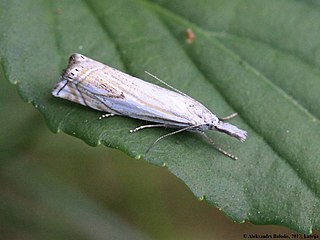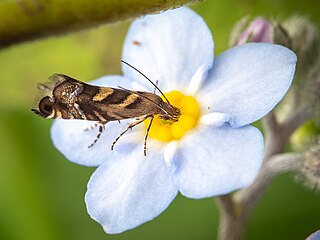
Nycteola revayana, the oak nycteoline, is a moth of the family Nolidae. The species was first described by Giovanni Antonio Scopoli in 1772. It is found from Europe and east across the Palearctic to Japan and India.

Crambus uliginosellus is a species of moth in the family Crambidae. It was first described by Zeller in 1850 and is currently found in most of Europe, except Portugal, Slovenia, Croatia and Ukraine.

Glyphipterix tungella is a species of sedge moth in the genus Glyphipterix. It is endemic to New Zealand and is found throughout the country. Larvae mine the leaves of small sedges. Adults of this species are day flying and inhabit sheltered scrub or grassy areas and forest clearings.
Dichomeris percnacma is a moth in the family Gelechiidae. It was described by Edward Meyrick in 1923. It is found in Peru and Amazonas, Brazil.
Hierangela erythrogramma is a moth in the family Gelechiidae. It is found in Burma.
Battaristis ardiophora is a moth of the family Gelechiidae. It was described by Edward Meyrick in 1914. It is found in Guyana, Brazil and Peru.
Anacampsis considerata is a moth of the family Gelechiidae. It was described by Edward Meyrick in 1922. It is found in Brazil (Amazonas) and Peru.
Procometis lipara is a moth in the family Autostichidae. It was described by Edward Meyrick in 1890. It is found in Australia, where it has been recorded from New South Wales.
Stenoma adoratrix is a moth of the family Depressariidae. It is found in Bolivia.
Mothonica fluminata is a moth of the family Depressariidae. It is found in Colombia and Suriname.
Antaeotricha heterosaris is a moth of the family Depressariidae. It is found in Guyana and French Guiana.
Antaeotricha enodata is a species of moth of the family Depressariidae. It is found in French Guiana.
Catoryctis subnexella is a moth in the family Xyloryctidae. It was described by Francis Walker in 1864. It is found in Australia, where it has been recorded from the Australian Capital Territory, New South Wales, South Australia and Tasmania.
Comotechna semiberbis is a moth in the family Depressariidae. It was described by Edward Meyrick in 1921. It is found in Peru.
Comotechna ludicra is a moth in the family Depressariidae. It was described by Edward Meyrick in 1920. It is found in Guyana.
Coptotelia nigriplaga is a moth in the family Depressariidae. It was described by Paul Dognin in 1904. It is found in Colombia and Ecuador.
Odites carcharopa is a moth in the family Depressariidae. It was described by Edward Meyrick in 1914. It is found on the Comoros in the Indian Ocean.
Antaeotricha umbratella is a moth in the family Depressariidae. It was described by Francis Walker in 1864. It is found in Brazil (Amazonas), Panama, Costa Rica, Guyana and French Guiana.
Antaeotricha binubila is a moth in the family Depressariidae. It was described by Philipp Christoph Zeller in 1854. It is found in Brazil (Amazonas) and Suriname.
Imma caelestis is a moth in the family Immidae. It was described by Edward Meyrick in 1906. It is found in western China.


